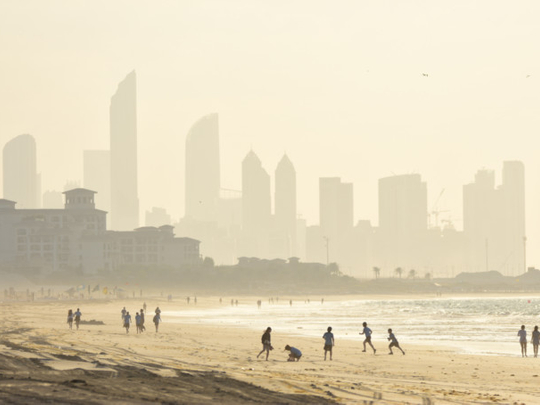
As real estate in Abu Dhabi becomes more affordable and developers remain confident in creating real estate products that buyers want, it may just be the right time to invest in the UAE capital. “The anticipated delivery of new projects in the short to medium term is expected to increase investment opportunities, which in turn will have a positive effect on transaction volumes,” says John Stevens, managing director of Asteco.
He adds: “With an expected 2,550 apartments expected to be delivered by the end of the year and 1,350 already delivered in the first quarter, it is expected that both rental rates and sales rates will see further marginal declines.”
According to Cavendish Maxwell research, Abu Dhabi’s supply pipeline includes nearly 3,400 units on Saadiyat island, 5,400 units on Yas island and 8,200 upcoming units on Reem island, among other areas, expected to be gradually handed over until 2020.
“Supply pressure will be felt more strongly on projects that are undifferentiated from the existing stock, ie offering more of the same in terms of amenities, unit sizes and payment plans that are weighted heavily towards pre-construction payments as opposed to post-handover,” says Manika Dhama, senior consultant at Cavendish Maxwell. “Developers need to respond to current consumer needs through planning more efficient designs and launching lower-priced inventory, especially options targeting end users.”
While Abu Dhabi’s economy is strongly linked to oil price stability and government spending, the real estate sector shouldn’t wait for external factors to spur activity.
“Housing demand has been impacted by these factors, with redundancies in the oil and gas sector and mergers of government-backed entities,” says Dhama. “Consumers are more cost-conscious today. Thus, any improvement in transaction levels is only likely when developer offerings are adjusted to current demand dynamics, both from regional investors and end users.”
Mid-market approach
Sameh Muhtadi, CEO of Bloom Holding, says developers should pay more attention towards addressing the mid-market housing gap. He points to his success with Bloom Heights, a mid-market development in Dubai’s Jumeirah Village Circle (JVC), which he says can be replicated in Abu Dhabi.
“We believe that our success selling 80 per cent within a week last year was partly due to the quality of the design, the list of amenities and its prime location in JVC,” says Muhtadi.
At Cityscape Abu Dhabi, Bloom Holding will be showcasing its projects in the capital: Park View and Soho Square on Saadiyat Island and Bloom Marina in Al Bateen. The Abu Dhabi-based developer is also launching another project in JVC, Bloom Towers.
In with the new
Stevens says that already existing or under-construction projects offer quite an attractive menu for buyers to choose from.
“The market is expected to see further corrections over the next year, followed by a stabilisation phase, with increase in demand for good quality and competitively priced products,” says Stevens. “We’ve already witnessed off-plan, competitively priced villas with flexible payment plans generating interest from potential investors, versus a decrease in demand for older stock.”
David Godchaux, CEO of Core Savills, on the other hand, points out that most buyers had been expecting further price drops. “Even though there are very good bargains available in both the off-plan and the ready market, buyers are not confident on taking on debt as they are uncertain of their future course, hence they are holding back,” says Godchaux.
One reason buyers are hesitating is an anticipated interest rate hike. “Unlike some other countries, buyers in the UAE cannot secure fixed interest rates for more than two to five years, exposing themselves to the risk of future interest rate hikes,” Godchaux explains.
Nonetheless, as in most market cycles, there are astute investors who are looking to capitalise on the current market conditions.
“If an end user or investor is not necessarily pressed for access to finance, an off-plan product from reputed developers complying with regulations and nearing completion make for a potentially attractive investment,” says Godchaux.
Abu Dhabi’s new property law, including a mandatory escrow account and developer accountability for delays, has helped boost investor confidence.
“Initiatives, such as the recently implemented Abu Dhabi real estate law show that the government is committed to a fair and transparent property market, encouraging local and international investment alike,” says Talal Al Dhiyebi, Chief Development Officer of Aldar.
Where to look
Developers in Abu Dhabi are adjusting their portfolio to match demand, according to Cluttons, which is what TDIC is doing with its Saadiyat Lagoons district, where two-bedroom town homes start at Dh2.4 million.
“Up to now the capital values of apartments on Saadiyat island have held up reasonably well, given the high quality of the offering here,” says Faisal Durrani, partner and head of research at Cluttons. “However, sea-view villa values have corrected sharply; we saw prices dip by 19 per cent last year.”
According to Stevens the new competitive pricing for the Saadiyat Lagoons off-plan villas, with flexible payment plans, has piqued the interest of potential buyers.
Furthermore, Stevens says that even with the current market slowdown, Reem Island and Al Raha Beach also remain as major areas for new investments.
For affordable property, Stevens recommends Al Reef. “It offers a community with affordable, good-quality products, which is still recording positive demand.”
Sweet spot
According to Durrani, a sweet spot has emerged in the capital for property priced between Dh800 and 900 per square foot. This explains why Al Reef Villas recently saw a 2.4 per cent increase to Dh850 per square foot, while prices in Al Ghadeer Villas dropped by 5 per cent to Dh950 per square foot, according to Cluttons’ Abu Dhabi Spring 2017 Property Market Outlook.
“This brings them slightly more in line with each other,” says Durrani. “There is a renewed focus on what is perceived to be affordable among buyers. The added advantage of Al Reef Villas is, of course, the proximity to Abu Dhabi island, which has in part supported the slight rise in capital values in this submarket.”
Rents
According to Stevens, 150 villas were handed over in Abu Dhabi in the first quarter and will be followed by 750 homes by year end.
“The addition of these extra units against a backdrop of limited public spending, job cuts and a reduction in staff allowances will see further pressure placed on the market,” Stevens cautions. The trend was especially visible at the top end of the property spectrum, where rents have fallen sharply.
Durrani says, “This is reflecting the aversion to rented luxury accommodation, which has been exacerbated by a slowdown in the rate of [creation of] senior-level jobs across the emirate.”
Dhama says tenants may well move from older to newer areas, provided the rental payout does not squeeze their budgets. “Landlords may need to provide incentives to entice tenants, over and above flexibility of payment through multiple cheques,” says Dhama. “Occupancy risk will continue in larger units as senior-level executives remain most impacted by readjusted employee benefits, such as housing allowances.”
Core Savills predicts apartment rents to drop anther 7 per cent and villas by up to 10 per cent this year, particularly prime units.
“In a market that is contracting, an introduction of backdated municipality tax adds further pressure on the rising overall household costs, while the reinstatement of the 5 per cent rental cap is not relevant in the backdrop of widespread rental drops, as a rental cap is generally applicable to keep rising rents in check,” says Godchaux.
Cluttons, for its part, expects rates to dip 5-7 per cent this year, with the top end experiencing sharper falls.
“The focus of activity is very much centred on what is perceived to be affordable, so from a developer or investor perspective, this is definitely going to be the core focus of the market,” says Durrani. “Affordable housing is something we have flagged before and given where we are in the current property cycle, the demand for affordable homes is probably the strongest it has ever been.”











